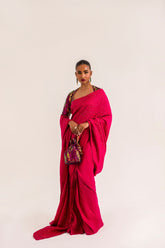In the vibrant landscape of Indian ethnic wear, the choice between a Jacket Lenga and a Traditional Lenga can significantly influence your attire's style, comfort, and suitability for various occasions. Whether you're preparing for a wedding, festival, or another special event, understanding the distinctions between these two styles will help you make an informed decision that suits your preferences and needs.
Introduction to Jacket Lengas and Traditional Lengas

Both Jacket Lengas and Traditional Lengas are prominent choices in traditional Indian attire, each offering unique characteristics that appeal to different tastes and occasions. A Jacket Lenga typically features a long jacket or blouse paired with a flared skirt, often adorned with intricate embroidery or embellishments. On the other hand, a Traditional Lenga consists of a blouse (choli) paired with a flared skirt (lenga) and a matching dupatta (scarf), showcasing traditional craftsmanship and cultural motifs.
Fabric Choices
Fabric plays a pivotal role in determining the look, feel, and comfort of your Lenga ensemble. Jacket Lengas often feature luxurious fabrics like silk, velvet, or brocade for the jacket, providing a regal and structured appearance. In contrast, Traditional Lengas offer a broader range of fabric choices, from lightweight georgette and chiffon for a flowing silhouette to rich silk and velvet for a more opulent feel.
Design Elements
The design elements distinguish Jacket Lengas and Traditional Lengas in terms of aesthetics and detailing. Jacket Lengas are characterized by their ornate jackets, which may feature intricate embroidery, zardozi work, or mirror embellishments. These jackets often serve as statement pieces, adding a layer of sophistication and grandeur to the ensemble. Traditional Lengas, while also embellished, typically showcase traditional motifs like paisleys, floral patterns, or geometric designs, reflecting regional craftsmanship and cultural heritage.
Occasions and Cultural Context

Understanding the appropriate occasions and cultural contexts for Jacket Lengas and Traditional Lengas is essential. Jacket Lengas are well-suited for formal events such as weddings, receptions, and festive celebrations where a touch of contemporary elegance is desired. They offer a modern twist to traditional attire, making them popular among fashion-forward individuals. Traditional Lengas, on the other hand, are timeless classics that are ideal for religious ceremonies, traditional festivals, and cultural gatherings, where showcasing heritage and authenticity is paramount.
Comfort and Fit

Comfort and fit are crucial considerations when choosing between a Jacket Lenga and a Traditional Lenga. Jacket Lengas, with their structured jackets and tailored fit, provide a more defined silhouette that can be flattering for various body types. They offer support and coverage while allowing ease of movement, making them comfortable choices for extended wear. Traditional Lengas, known for their flowing skirts and adjustable blouse designs, offer flexibility and breathability, ensuring comfort throughout long ceremonies and festivities.
Customisation Options
Customisation options vary between Jacket Lengas and Traditional Lengas, depending on personal preferences and designer capabilities. Jacket Lengas often allow for bespoke tailoring of the jacket, including adjustments to sleeve length, neckline, and embroidery patterns. This flexibility enables you to create a unique ensemble that reflects your individual style and complements your body shape. Traditional Lengas also offer customisation in terms of fabric choices, colour combinations, and embellishment preferences, allowing you to personalise every aspect of your attire to suit the occasion.
Cost and Budgeting

Cost considerations play a significant role in the decision-making process when selecting a Jacket Lenga or Traditional Lenga. Jacket Lengas, particularly those crafted from premium fabrics and intricate detailing, tend to be higher in cost due to the craftsmanship involved. They are often investment pieces that justify their price through quality and design. Traditional Lengas, while also available in a range of price points, offer more affordable options depending on the fabric and craftsmanship. Budget-conscious individuals may opt for Traditional Lengas without compromising on style or cultural significance.
Popularity and Trends

The popularity and trends surrounding Jacket Lengas and Traditional Lengas evolve with fashion preferences and cultural influences. Jacket Lengas have gained traction among modern brides and fashion enthusiasts seeking contemporary interpretations of traditional attire. They are favoured for their versatility and ability to blend traditional craftsmanship with modern silhouettes. Traditional Lengas, rooted in cultural heritage and timeless appeal, continue to resonate with individuals celebrating customs and rituals, maintaining their popularity across generations.
Maintenance and Care
Proper maintenance and care are essential for preserving the beauty and longevity of your Lenga ensemble, whether it's a Jacket Lenga or a Traditional Lenga. Both styles require delicate handling and storage to protect delicate fabrics and intricate embellishments from damage. Regular dry cleaning is recommended for removing stains and maintaining fabric integrity. Additionally, storing your Lenga in a cool, dry place away from direct sunlight helps prevent discolouration and fabric deterioration over time.
Conclusion
Choosing between a Jacket Lenga and a Traditional Lenga ultimately depends on your personal style preferences, the occasion, and cultural considerations. A Jacket Lenga offers contemporary elegance and customisation options, making it ideal for modern celebrations and fashion-forward individuals. In contrast, a Traditional Lenga embodies cultural heritage and timeless charm, suited for traditional ceremonies and preserving customs. By understanding the nuances of each style, you can select a Lenga ensemble that not only enhances your appearance but also reflects your cultural identity and celebrates the spirit of festivity and tradition.




















































































































